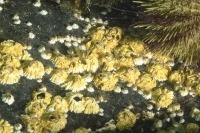
(Photo: Claire Goodwin)
Northern Rock Barnacle
Semibalanus balanoides
A small white barnacle that grows up to 1.5 centimetres in diameter. It has six calcified shell plates, a diamond-shaped opening, and a membranous base to its shell.
Authority
Linnaeus, 1767
Classification Details
Phylum: Arthropoda (arthropods); Subphylum: Crustacea (crustaceans); Infraclass: Cirripedia (barnacles).
Habitat
A common shore species. Found on both sides of the Atlantic Ocean and on Pacific coasts of North America. On the Atlantic coast of America and Canada it is found from the Arctic to Cape Hatteras.
Diet
A suspension feeder. Uses thoracic appendages (modified legs) called cirri to filter zooplankton and detritus from the water. It holds the cirri steady if there is current or beats them rhythmically if there is no current. A barnacle can be imagined as a shrimp stuck by its head to a rock and kicking food into its mouth.
Reproduction
Cross-fertilizing hermaphrodite. Each individual has both male and female organs but cannot fertilize its own eggs. Barnacles have a penis which is up to eight times their body length (the longest penis to body ratio in the animal kingdom). They use this to search around it to find a receptive functional female. Each functional female needs to mate with more than one functional male to fertilize all its eggs. Adults incubate fertilized embryos over winter and then release nauplii larvae in the spring. Release coincides with the spring phytoplankton bloom. Larvae spend around two months in the plankton before developing into cyprid larvae and settling onto a rock. Lifespan depends on the position on the shore. Those on the low shore typically die in their third year, whereas those higher up on the shore can live for five or six years.
Fun Facts
Adults need to release larvae during the spring phytoplankton bloom to maximize larval survival. When the bloom starts and they ingest phytoplankton, adults release a hatching chemical. This makes the embryos twitch rapidly until they break the egg membrane and are released.
After mating, the barnacle's penis degenerates and is re-grown the following spring.
References
Anderson DT (1994) Barnacles. Structure, function, development and evolution. Melbourne: Chapman & Hall. Herrera M, Wethey D, Vázquez E and Macho G (2019) Climate change implications for reproductive success: temperature effect on penis development in the barnacle Semibalanus balanoides. Marine Ecology Progress Series 610, 109–123. Hoch MJ, Schneck DT and Neufeld CJ (2016) Ecology and evolution of phenotypic plasticity in the penis and cirri of barnacles. Integrative and comparative biology 56, 728–740. White N (2008) Semibalanus balanoides An acorn barnacle. In Tyler-Walters H. and Hiscock K. (eds) Marine Life Information Network: Biology and Sensitivity Key Information Reviews, [on–line]. Plymouth: Marine Biological Association of the United Kingdom. https://www.marlin.ac.uk/species/detail/1376 Accessed online 22 January 2020. World Register of Marine Species (2020) Semibalanus balanoides (Linnaeus, 1767) – WoRMS Taxon Details. http://www.marinespecies.org/aphia.php?p=taxdetails&id=106210 Accessed online 22 January 2020.

